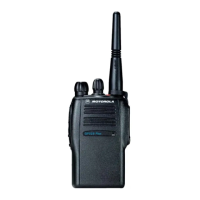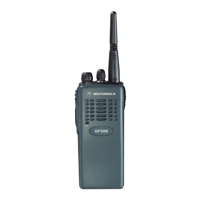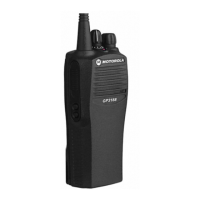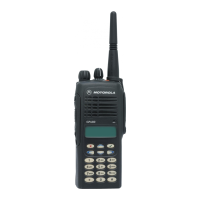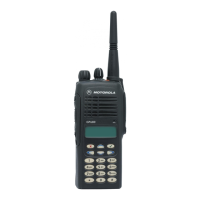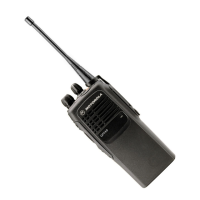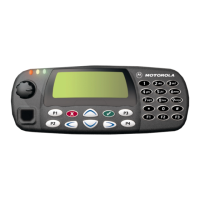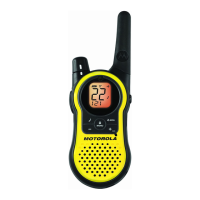




Do you have a question about the Motorola GP328 and is the answer not in the manual?
Details Motorola's two-year warranty for radios and one-year for batteries, plus usage recommendations.
Provides contact numbers for queries and fields for user reference of radio details.
Identifies and illustrates the various physical components of the radio device.
Explains the function of the volume knob for power control and the channel selector for switching channels.
Details functions assigned to programmable buttons via short press, long press, and press-and-hold actions.
Lists and describes advanced functions controllable via programmable buttons like scan, transmit power, and squelch.
Explains how to initiate phone calls and control the radio's backlight using programmable buttons.
Describes the primary function of the PTT button for transmission and microphone usage for clear audio.
Explains the use of the keypad for dialing and the meaning of positive/negative indicator tones.
Maps programmable button actions to specific audio indicator tones for feedback.
Details audio feedback for keypad lock status and repeater/talkaround mode selection.
Guides users on checking battery level via LED indicators and the process of recharging the radio's battery.
Provides instructions for attaching and removing the battery and antenna from the radio.
Explains how to remove the antenna and attach the belt clip securely to the radio.
Details the procedure for removing the belt clip and the steps to power the radio on and off.
Instructs users on how to adjust the radio's audio volume level using the designated controls.
Guides users on selecting channels, initiating calls, and receiving calls on the radio.
Explains the Talkaround feature for direct radio-to-radio communication without a repeater.
Describes how to adjust squelch levels to filter unwanted transmissions and background noise.
Details how to change transmit power levels for range and battery conservation.
Explains how to initiate and terminate the scan operation on the radio.
Describes the Talkback feature during scan and how to temporarily remove nuisance channels from the scan list.
Details re-adding deleted channels, alerts for channel discovery, and priority channel scanning.
Guides users on entering the phone mode and the methods for sending access codes to initiate calls.
Outlines the complete process for making a phone call session on the radio.
Explains how to access stored numbers and the initial steps for sending phone numbers.
Details methods for dialing phone numbers, including speed dial and direct keypad entry.
Provides guidance on conducting conversations and properly ending phone calls on the radio.
Provides instructions for safe radio operation and compliance with RF exposure standards.
Details safe practices for portable radio use and managing electromagnetic interference.
Warns about hazards in vehicles with airbags, explosive atmospheres, and blasting areas.
Cautions users about using damaged antennas and safe handling of batteries to prevent damage or injury.
Details Motorola's two-year warranty for radios and one-year for batteries, plus usage recommendations.
Provides contact numbers for queries and fields for user reference of radio details.
Identifies and illustrates the various physical components of the radio device.
Explains the function of the volume knob for power control and the channel selector for switching channels.
Details functions assigned to programmable buttons via short press, long press, and press-and-hold actions.
Lists and describes advanced functions controllable via programmable buttons like scan, transmit power, and squelch.
Explains how to initiate phone calls and control the radio's backlight using programmable buttons.
Describes the primary function of the PTT button for transmission and microphone usage for clear audio.
Explains the use of the keypad for dialing and the meaning of positive/negative indicator tones.
Maps programmable button actions to specific audio indicator tones for feedback.
Details audio feedback for keypad lock status and repeater/talkaround mode selection.
Guides users on checking battery level via LED indicators and the process of recharging the radio's battery.
Provides instructions for attaching and removing the battery and antenna from the radio.
Explains how to remove the antenna and attach the belt clip securely to the radio.
Details the procedure for removing the belt clip and the steps to power the radio on and off.
Instructs users on how to adjust the radio's audio volume level using the designated controls.
Guides users on selecting channels, initiating calls, and receiving calls on the radio.
Explains the Talkaround feature for direct radio-to-radio communication without a repeater.
Describes how to adjust squelch levels to filter unwanted transmissions and background noise.
Details how to change transmit power levels for range and battery conservation.
Explains how to initiate and terminate the scan operation on the radio.
Describes the Talkback feature during scan and how to temporarily remove nuisance channels from the scan list.
Details re-adding deleted channels, alerts for channel discovery, and priority channel scanning.
Guides users on entering the phone mode and the methods for sending access codes to initiate calls.
Outlines the complete process for making a phone call session on the radio.
Explains how to access stored numbers and the initial steps for sending phone numbers.
Details methods for dialing phone numbers, including speed dial and direct keypad entry.
Provides guidance on conducting conversations and properly ending phone calls on the radio.
Provides instructions for safe radio operation and compliance with RF exposure standards.
Details safe practices for portable radio use and managing electromagnetic interference.
Warns about hazards in vehicles with airbags, explosive atmospheres, and blasting areas.
Cautions users about using damaged antennas and safe handling of batteries to prevent damage or injury.
| Channel Capacity | 16 channels |
|---|---|
| Operating Temperature | -30°C to +60°C |
| Sealing | IP54 |
| Frequency Range | 136-174 MHz (VHF), 403-470 MHz (UHF) |
| Power Output | 1-5W (VHF), 1-4W (UHF) |
| Dimensions | 137 x 57.5 x 37.5 mm |
| Power Supply | 7.5V |
| Battery Life | 8 hours (High Power), 11 hours (Low Power) with standard NiMH battery |
| Weight | 420g (with standard battery) |
